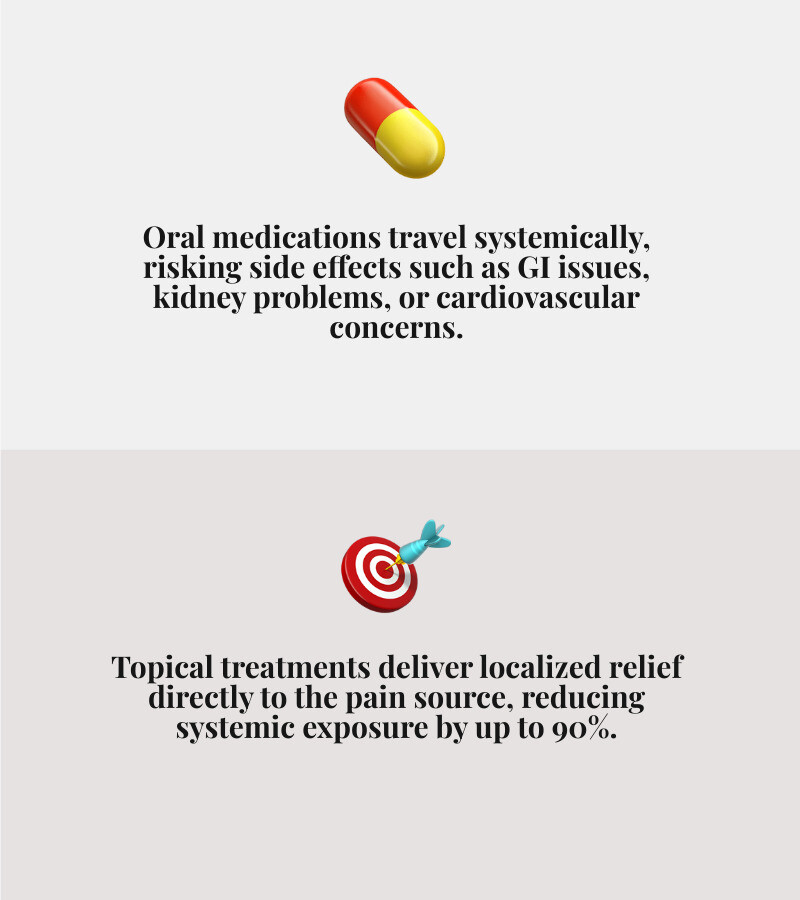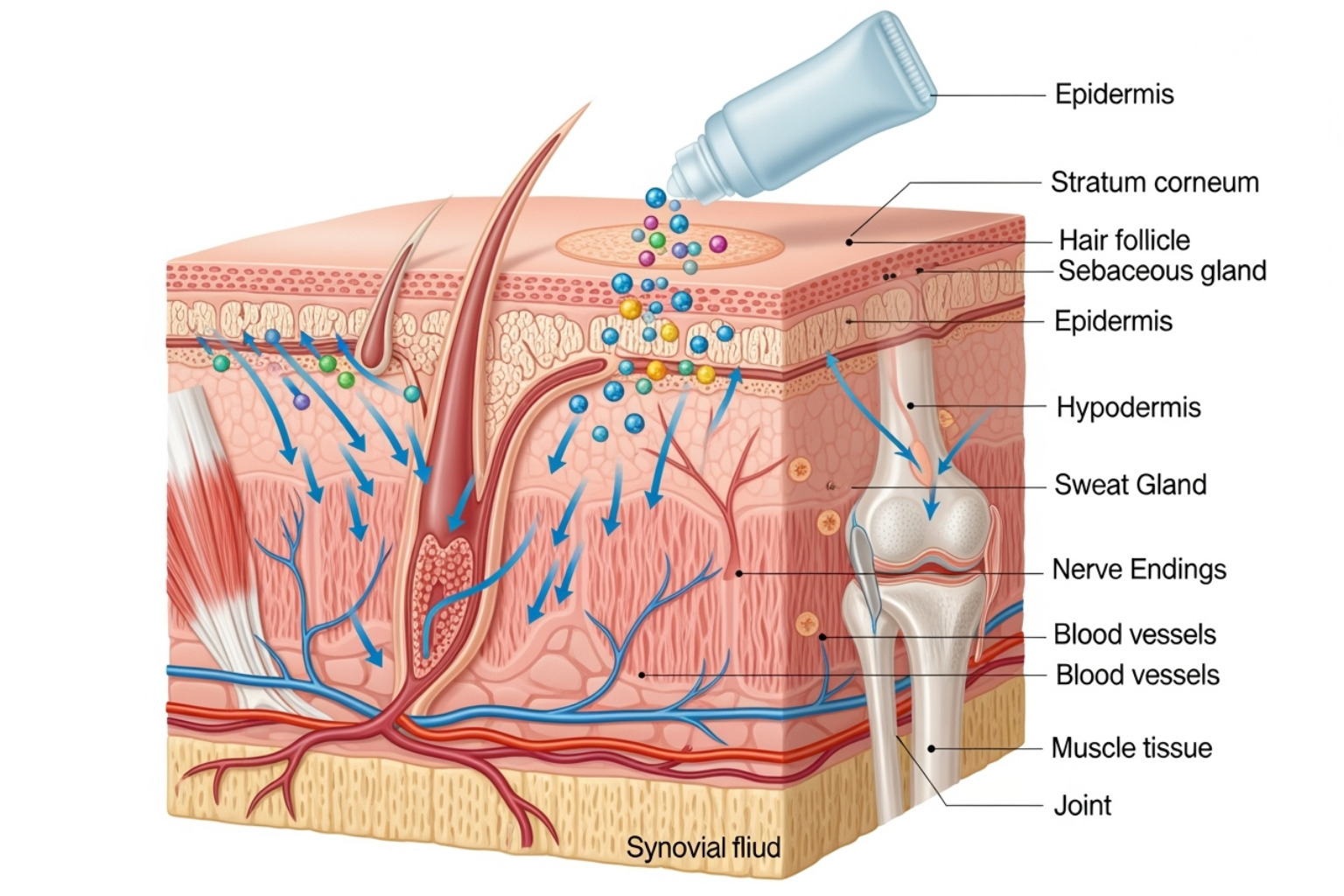Why Topical Solutions Are Changing Pain Relief
Topical for inflammation offers a powerful way to manage pain without the risks of oral medications. These creams, gels, or patches are applied directly to painful areas, allowing active ingredients to absorb through your skin and reduce swelling at the source. The key benefit is a nearly 90% reduction in systemic medication exposure compared to pills. Studies show significant effectiveness, with many users feeling relief within 30-60 minutes for conditions like arthritis, muscle soreness, and nerve pain.
If you're tired of pills that upset your stomach or cause long-term side effects, topical anti-inflammatories are a smarter alternative. They let you target pain right where it hurts—your aching knee, sore shoulder, or inflamed wrist—without flooding your entire body with medication.
While oral pain relievers travel through your digestive system and bloodstream, potentially causing stomach, kidney, or cardiovascular issues, topical treatments work locally. They penetrate the skin to reach the painful tissue, blocking the chemicals that cause inflammation. The result is targeted relief with a fraction of the risk.
This is especially important for chronic conditions, injury recovery, or post-workout soreness. You shouldn't have to choose between managing pain and protecting your health.
I'm Tony Enrico, and I've dedicated my work to helping people find effective, natural alternatives to traditional pain management. Through my experience with topical for inflammation solutions, I've seen how these treatments can restore comfort and mobility without the heavy burden of systemic side effects.

Understanding Topical Anti-Inflammatories and How They Work
Think of topical for inflammation treatments as precision-guided relief. Instead of sending medication throughout your body, you deliver it exactly where the pain lives. These treatments come in several forms: rich creams that moisturize, fast-absorbing gels, and patches that provide steady, long-lasting relief.
At Neuropasil, we've seen how targeted relief can transform someone's daily experience with pain. Our formulas focus on reaching nerve pain and muscle soreness right at the source. If you want to explore more, check out more info about anti-inflammatory creams.

The mechanism is sophisticated. When you apply a cream, the active ingredients penetrate the skin to reach the underlying muscles and joints. This direct route bypasses your digestive system entirely. Once there, the ingredients block pain-causing enzymes like COX, which your body uses to create prostaglandins—the chemicals responsible for inflammation and pain.
By interrupting this process at the source, these creams turn down your body's inflammatory response where you need it most. Because the medication works locally, very little enters your bloodstream. Research shows that topical anti-inflammatories reduce systemic exposure by approximately 90% compared to oral medications. This means a dramatically lower risk of the stomach, kidney, or cardiovascular issues associated with taking pills daily. For anyone who's dealt with the side effects of oral pain relievers, that's life-changing.
The scientific research on topical analgesic efficacy offers compelling evidence about how effective these treatments are.
The Active Ingredients Behind the Relief
When you reach for a topical for inflammation, you're using a blend of active ingredients designed to tackle pain at its source. These compounds, whether from a lab or nature, work beneath your skin to bring comfort.

At Neuropasil, we harness the power of natural ingredients like Aloe, Urea, and Menthol for fast-acting, soothing relief without harsh chemicals. If you're curious about our formula, you can Learn about our ingredients and see how each one contributes to your comfort.
NSAIDs (Nonsteroidal Anti-Inflammatory Drugs)
Topical NSAIDs are the same medications found in oral pain relievers, but in a cream. Diclofenac (often sold as Voltaren) is a common example. They work by blocking COX-2 enzymes, which create the prostaglandins that cause pain and swelling. This makes them highly effective for arthritis, especially in joints like the hands and knees.
Counterirritants
These ingredients create a distraction for your nervous system. By producing sensations of warmth or coolness, they redirect your brain's attention from the underlying pain.
- Menthol provides a cooling sensation, which is why we use it in Neuropasil for immediate comfort.
- Camphor produces a similar cooling or warming feeling.
- Methyl salicylate (oil of wintergreen) creates warmth.
For more ways to use natural anti-inflammatory strategies, see these 7 practical ways to use natural anti-inflammatories.
Natural Compounds
Nature offers powerful solutions for pain relief.
- Capsaicin, from chili peppers, depletes a neurotransmitter that sends pain signals to the brain. It's especially useful for nerve pain.
- Arnica, a flower extract, is traditionally used to reduce bruising, swelling, and soreness.
- Aloe vera has anti-inflammatory properties and moisturizes the skin, which is why it's a key part of Neuropasil's formula.
- Turmeric contains curcumin, a potent anti-inflammatory compound. Research continues to explore the Potential anti-inflammatory effects of Curcumin.
- CBD (cannabidiol) interacts with the body's endocannabinoid system to help regulate pain and inflammation.
Anesthetics and Salicylates
This group includes numbing agents and aspirin-like compounds.
- Lidocaine is a local anesthetic that blocks nerve signals, effectively numbing the painful area.
- Salicylates are chemically similar to aspirin and help reduce pain and inflammation when absorbed through the skin. If you are allergic to aspirin or take blood thinners, consult your doctor before using products with salicylates.
Key Benefits of Using a Topical for Inflammation
The real magic of a topical for inflammation is what it means for your life—gardening without a twinge in your knee or walking without your ankle protesting. That's what targeted relief can do.

Targeted Relief for Specific Aches and Pains
Topical treatments go exactly where you need them. You rub the cream on your sore shoulder, and it gets to work there, bypassing the digestive system. This is especially valuable for pain in joints close to the skin, like hands, knees, elbows, and ankles. They are effective for arthritis, muscle strains, sprains, and tendonitis. At Neuropasil, customers use our creams for everything from neuropathy and fibromyalgia to back pain and sore muscles, helping them reclaim the activities they love.
If you're struggling with arthritis pain, read more about [Beyond the Pill: How Topical Treatments Can Soothe Arthritis Pain](https://neuropasil.com/blogs/news/beyond-the-pill-how-topical-treatments-can-soothe-arthritis-pain).
A Safer Profile Compared to Oral Pills
If you've taken oral pain relievers, you know the side effects: stomach upset, ulcers, and kidney or cardiovascular risks. Topical treatments largely avoid these issues. By reducing systemic exposure by almost 90%, they dramatically lower your risk. This means fewer gastrointestinal issues, fewer drug interactions, and a safer option for long-term management of localized pain.
| Feature | Topical NSAIDs | Oral NSAIDs |
|---|---|---|
| Absorption | Localized, minimal systemic absorption | Systemic, absorbed throughout the body |
| GI Side Effects | Rare (mild skin irritation) | Common (stomach upset, ulcers, bleeding) |
| Heart/Kidney Risk | Very low | Moderate to high (especially with long-term use) |
| Drug Interactions | Less likely | More likely |
| Targeting | Pinpoint relief at application site | Whole-body effect |
| Overall Safety | Generally safer for localized pain | Higher risk of systemic side effects |
The Effectiveness of a topical for inflammation
Research gives a resounding "yes" to the question of effectiveness. Studies show topical analgesics can relieve pain by up to 50 percent, and with topical NSAIDs, 60% of patients achieved 50% pain relief. That's the difference between struggling through your day and enjoying it. Plus, they work quickly, with most taking effect within 30 to 60 minutes.
The Arthritis Foundation also recognizes their value for joint pain. You can explore their perspective on [Information on topical NSAIDs from the Arthritis Foundation](https://www.arthritis.org/drug-guide/medication-topics/topical-nsaids-offer-joint-pain-relief).
How to Use Anti-Inflammatory Creams Safely and Effectively
Getting the most out of your topical for inflammation is about using it correctly and safely. For conditions like hand arthritis, proper application is key, as you can learn in [Managing Arthritis in Your Hands: Dos and Don'ts](https://neuropasil.com/es/blogs/news/managing-arthritis-in-your-hands-dos-and-donts-for-daily-comfort).
Application Best Practices for Optimal Results
Follow these steps for the best results:
- Start with clean, dry skin to ensure the ingredients can penetrate effectively.
- Use the correct dosage. More isn't better. A pea-sized amount is often enough for a small area, while larger joints may need a bit more. Follow the product label.
- Gently massage the cream into your skin until it's fully absorbed.
- Wash your hands thoroughly after application to avoid transferring medication to your eyes or mouth. Consider gloves for capsaicin products.
- Avoid sensitive areas. Never apply to eyes, mucous membranes, broken skin, or open wounds.
- Do not use heating pads or tight bandages over the area, as this can increase absorption to unsafe levels and cause skin irritation.
Potential Side Effects and Who Should Be Cautious
While safer than pills, topical treatments can have side effects. The most common are mild skin reactions like redness, rash, or itching at the application site, affecting about 1 in 20 people. These usually resolve on their own.
Certain individuals should be cautious:
- People who have had open heart surgery should not use these products.
- Those with cardiovascular or kidney problems should consult a doctor first.
- Anyone with an aspirin allergy or taking blood thinners should avoid products with salicylates.
- If you are pregnant or breastfeeding, speak with your doctor before using any topical treatment.
Choosing a topical for inflammation and when to see a doctor
For acute pain like a sprain, a week or two of use is often sufficient. For chronic conditions, your doctor may recommend longer-term use with monitoring.
Call your healthcare provider if your pain worsens, persists beyond two weeks of use, or if you experience a severe skin reaction. It's always best to discuss any new or unusual symptoms with a professional.
Frequently Asked Questions about Topical Anti-Inflammatories
We hear a lot of great questions about topical for inflammation. Here are answers to some of the most common ones.
How long does it take for topical anti-inflammatories to work?
Most topical pain relievers start working within 30 to 60 minutes. You might feel a cooling or warming sensation as the cream begins to take effect. For some ingredients like capsaicin, the full benefit may require consistent use over several days or even a few weeks to desensitize nerve endings. Patience is key!
Can I use a heating pad with an anti-inflammatory cream?
No. Never use a heating pad or apply a tight bandage over a topical anti-inflammatory. Heat and occlusion (covering the area) can dangerously increase the absorption of the medication, raising the risk of systemic side effects and skin burns. Let the cream work on its own.
Are topical creams as effective as taking a pill?
For localized pain in joints close to the skin (like hands, knees, and elbows), studies show that some topical NSAIDs can be as effective as their oral counterparts. The key difference is that topicals achieve this with significantly fewer systemic side effects. For widespread pain, an oral medication may be more appropriate, but for targeted relief, topicals are an excellent and often equally effective choice.
Conclusion
When you're dealing with persistent pain, you shouldn't have to choose between relief and your overall health. Topical for inflammation solutions offer a remarkable alternative that eliminates this impossible choice.
As we've seen, these treatments deliver targeted relief by penetrating the skin to block pain and swelling at the source, all while reducing systemic medication exposure by nearly 90% compared to pills. This means you get pinpoint accuracy for your aches—whether it's an arthritic knee, a strained shoulder, or nerve pain—without the stomach, kidney, and cardiovascular risks of oral medications. Relief can begin in as little as 30 minutes, helping real people get back to their lives.
At Neuropasil, our mission is built on this principle of targeted, natural relief. Our formula uses Aloe, Urea, and Menthol to provide fast-acting comfort for nerve pain, sore muscles, and joint discomfort. Customers, from athletes to those with chronic conditions, trust Neuropasil to help them reclaim their comfort and mobility.
You deserve pain management that works with your body. Topical for inflammation treatments offer a smarter, safer way to address pain without compromising your well-being.
If you're ready to experience the difference that targeted, natural relief can make, we invite you to be part of our journey. [Discover targeted relief for your aches and pains](https://neuropasil.com/products/neuropasil-nerve-pain-relief-cream-4-oz) with Neuropasil, and put comfort back in control.
References
The information in this article is supported by research and insights from the following credible sources:
- Derry S, et al. (2017). Topical analgesics for acute and chronic pain in adults ‐ an overview of Cochrane Reviews. Cochrane Library.
- Konya, M. (2022). Are Topical Anti-Inflammatory Creams Worth the Rub? Cleveland Clinic.
- Mayo Clinic Staff. (2023). Arthritis pain: Treatments absorbed through your skin. Mayo Clinic.
- Jorge LL, et al. (2011). Topical preparations for pain relief: Efficacy and patient adherence. NCBI.
- The Arthritis Foundation. Topical NSAIDs Offer Joint Pain Relief. Arthritis Foundation.
- National Center for Biotechnology Information (2021). Potential anti-inflammatory effects of Curcumin. PubMed.
- Tillu DV, et al. (2012). Resveratrol engages AMPK to inhibit noxious stimuli-evoked activation of spinal microglia. Shopify CDN.
- Healthline (2022). 7 Topical Pain Relief Products, Reviewed. Healthline.













